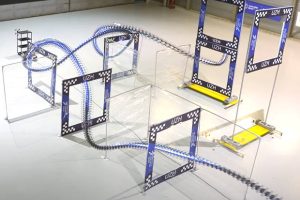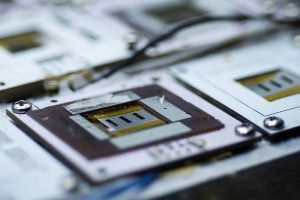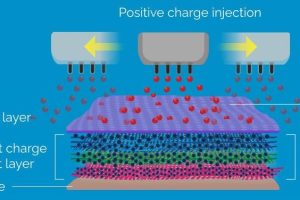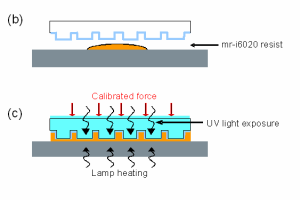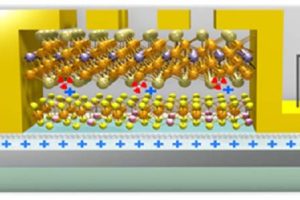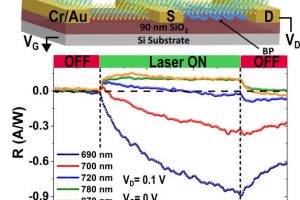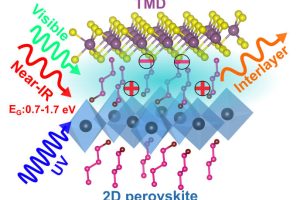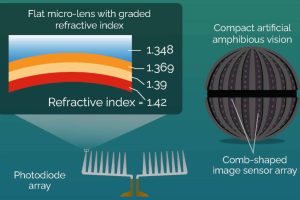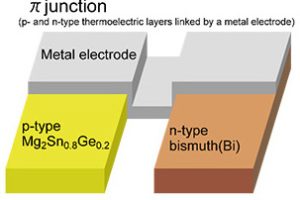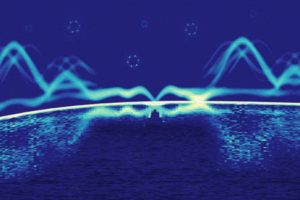The University of Zurich is teaching drones to fly at the highest possible speed thorough complex environments. “Our algorithm leverages classical topological path planning and deep reinforcement learning,” according to the University’s Robotics and Perception Group. In the first step, (right) many collision free paths are found using a probablistic rodmap method. After this, the paths are filtered with different ...
Research
The latest electronics research news from within the industry and universities from around the world.
Five year life for perovskite solar cell, and a way to accelerate life testing
Princeton University is predicting five years, and maybe 30 years, of outdoor life from a Perovskite solar cell stack-up invented in its labs. The key is a 2D material barrier layer between the photon-absorbing perovskite layer and the hole transport layer. “While the idea of a 2D capping layer isn’t new, it is still considered an emerging technique,” according to ...
Gradient doping improves triboelectric nano-generators
Graduated charge-confinement could be the key to much improved triboelectric nano-generators (TENGs), according to the Gwangju Institute of Science and Technology and Chonnam National University in Korea, which have been working on suitable structures. Triboelectric generators produce power through electrostatic induction when dissimilar insulating materials are brought together and parted (right, and far below). Two of the things that push ...
UV-NIL extended to below 10nm
Researchers from Tokyo University have uncovered molecular properties that help fill nanometer-sized gaps in the nanopatterning mould for ultraviolet nanoimprint lithography. Ultraviolet nanoimprint lithography (UV-NIL) is a method of creating patterns at the nanoscale with widespread applications in optoelectronics, photonics, and biology due to its low cost and scalability. However, current UV-NIL resolution is limited below 10 nm, and higher ...
Protonic gate spintronics – a tool for low-power ‘electronics’ beyond CMOS?
Electric gate-controlled exchange-bias effect in van der Waals heterostructures has been has observed for the first time, according to RMIT University in Australia, which describes the effect as “a promising platform for future energy-efficient, beyond-CMOS electronics”. “To date, very limited electrically tunable exchange-bias effects have been experimentally demonstrated in some oxide multi-ferroic thin film systems”, according to the university, but ...
More optically-active 2D heterostructures from Monash University
Monash University as been looking into stacks of differing 2D materials with the Indian Institute of Technology Bombay, yesterday revealing tuneable photon absoption from perovskites layered with transition metal dichalcogenides. At the same time, the team revealed two other optically-active 2D parings: WSe2 – SnSe2, and black phosphorous with MoS2. All the pairings are held in stacks by van der ...
Dissimilar 2D materials stack harmoniously to turn photons into electrons
The interfaces in assemblies of 2D materials could produce opto-electronics devices, according to Monash University in Australia, which is designing them using density functional theory (DFT) based band-structure modelling. “2D perovskites show interesting photo-physical properties and better stability compared to typical bulk perovskites,” according to Monash. “However, till now, near-infrared and visible-range optoelectronic device performance metrics of 2D perovskites have ...
Crab-inspired image sensor works on land and in water over 360°
The eye of the fiddler crab has inspired an artificial image sensor that works on land and in water without refocusing. This crab moves freely between aquatic and terrestrial environments, and to be effective in both its eyes have flat corneas with a graded refractive index profile, according to the Gwangju Institute of Science and Technology in Korea, where the ...
Thumbnail sized thermelectric generator is non-toxic for IoT
Researchers in Japan have micro-fabricated a thermoelectric generator for IoT devices from non-toxic materials. The proof-of-concept consists of 36 junctions, each made from p-type Mg2Sn0.8Ge0.2 working against n-type bismuth. “The output voltages of thermoelectric conversion modules and devices generally decrease as their sizes diminish,” according to the Japanese National Institute for Materials Science (NIMS). “An approach to overcoming this miniaturisation-related ...
2D material offers novel spin state for spintonics
Students of spintronics have another spin state to add to their tool box: a 2D material hosting a ‘spiral spin liquid’ – in which magnetic spins form fluctuating corkscrew-like structures. In this case, the material is the van der Waals honeycomb magnet iron trichloride, which has a layer of iron atoms sandwiched between two layers of chlorine atoms, and can ...
 Electronics Weekly Electronics Design & Components Tech News
Electronics Weekly Electronics Design & Components Tech News
